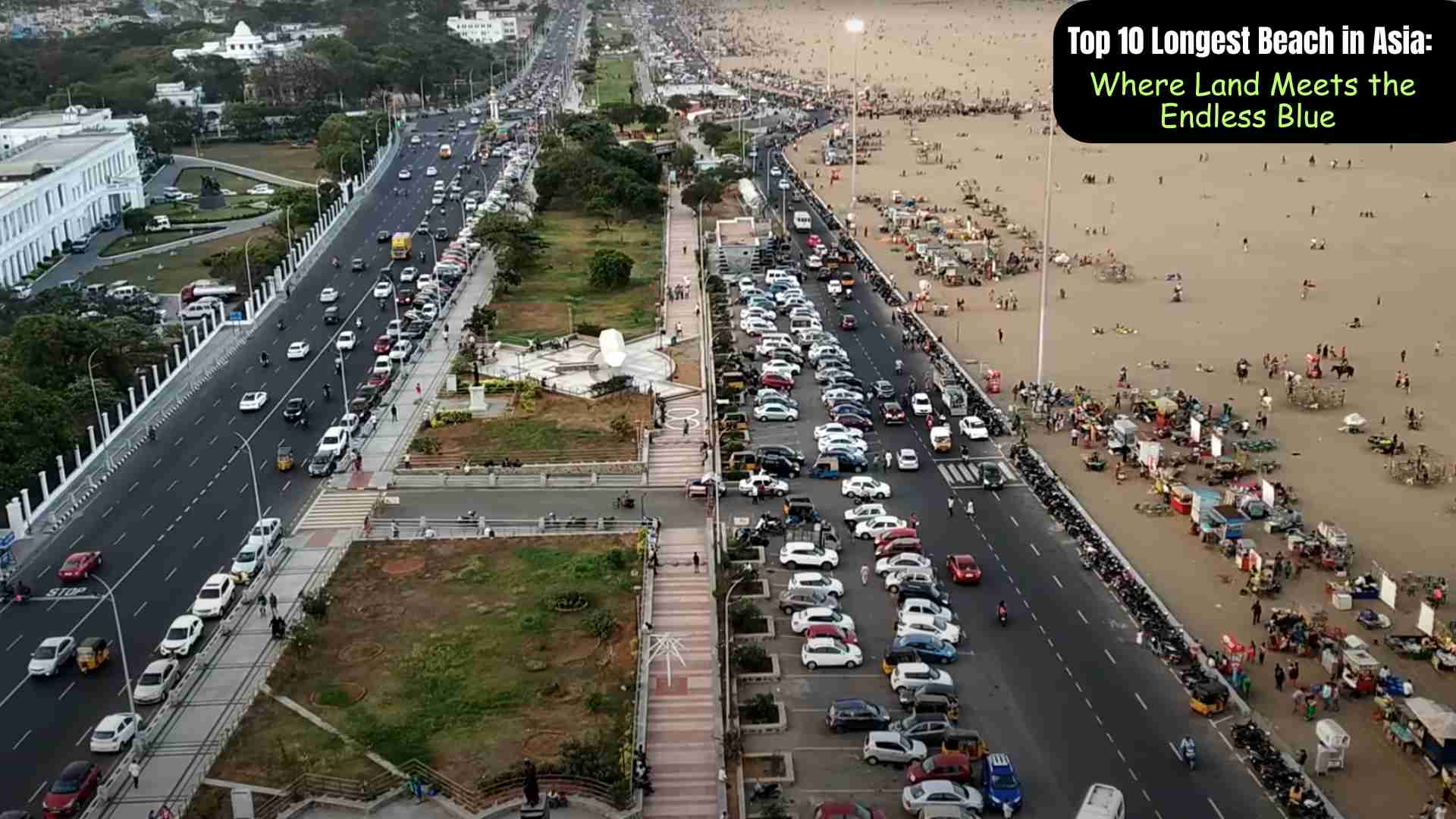Ever wondered where to find the longest stretch of sand in Asia? You’re not alone. Whether you’re a beach walker, a sunset chaser, or just someone who loves the sea breeze on your face, discovering the top 10 longest beaches in Asia is like opening a treasure chest of nature’s finest coastlines.
Asia is home to a stunning mix of coastlines—from wild and untouched shores to bustling beachfronts lined with street food, music, and history. And some of them are so long, you could walk for hours and still not see the end. Let’s begin this journey and explore some of the most awe-inspiring long beaches across the continent.
1. Marina Beach, India – 13 km
Let’s start with the undisputed champion: Marina Beach in Chennai, India. At around 13 kilometers in length, it holds the title of the longest natural urban beach in Asia, and arguably one of the longest in the world too.
It’s not just the size that makes Marina special. This beach has a soul. Locals gather here every morning for walks and yoga, while evenings buzz with snacks, street performers, and families enjoying the sea breeze. Yes, it gets crowded. And yes, it’s chaotic at times. But that’s part of the charm. You’ll find fried fish, spicy sundal, and slices of raw mango sprinkled with chili—classic Chennai beach snacks.
What to know:
- Swimming isn’t allowed in most areas due to strong undercurrents.
- Best time to visit: early morning or just before sunset to avoid the heat.
- There are monuments, statues, and memorials along the promenade worth seeing.
2. Cox’s Bazar Beach, Bangladesh – 120 km
Now imagine this: a 120 km stretch of uninterrupted sandy beach. That’s Cox’s Bazar for you—the longest sea beach in the world by length, according to many locals and international travelers alike. Nestled in southeastern Bangladesh, Cox’s Bazar is more than just long—it’s beautiful, serene, and rich with coastal culture.

The beach changes personality depending on where you go. Laboni Point is always buzzing with tourists, but head south toward Inani or Himchari, and you’ll find quieter spots with golden sand and clear blue water. The sunset here is something else—fiery orange skies melting into the Bay of Bengal.
What to know:
- The town itself is developing fast with lots of hotels and restaurants.
- Try fresh seafood near Sugandha Point.
- Take a rickshaw ride along the beach road—it’s simple but unforgettable.
3. Casuarina Beach (Tanjung Aru), Malaysia – ~8 km
Just outside Kota Kinabalu in Sabah, Malaysia lies Tanjung Aru Beach, often referred to as Casuarina Beach by locals due to the rows of wispy casuarina trees that frame the shoreline. It stretches around 8 kilometers, and while that might seem short compared to Cox’s Bazar, it’s still one of the longest in Southeast Asia.
What makes Tanjung Aru truly stand out isn’t just its size—it’s the vibe. Think fiery sunsets, gentle waves, and locals gathering in the evening with grilled corn and satay in hand. You can see planes descend toward the nearby airport right over the sea, which adds a surreal twist to the view.
What to know:
- The beach is undergoing some development; check ahead if access is limited.
- Grab a fresh coconut and watch the sky turn purple-orange.
- Popular with both tourists and locals, especially on weekends.
4. Kuakata Beach, Bangladesh – 18 km
Often overshadowed by Cox’s Bazar, Kuakata Beach is a hidden gem in southern Bangladesh. Locals fondly call it the “Daughter of the Sea”, and it stretches an impressive 18 kilometers. But what truly makes Kuakata unique? It’s one of the rare beaches in the world where you can watch both sunrise and sunset over the sea, standing in the same spot.
It’s less commercialized than Cox’s Bazar, so you’ll find more peace and fewer crowds. The beach has a wild beauty—fishermen mending nets, flocks of seagulls diving into the waves, and red crabs scurrying over the sand. The nearby forests and mangrove trails add to the adventure.
What to know:
- Visit during winter (November–February) for the best weather.
- Ideal for nature lovers and photographers.
- Don’t miss the nearby Buddhist temple and Rakhine villages.
5. Pantai Cenang to Pantai Tengah, Langkawi, Malaysia – Combined ~6 km
Langkawi, the tropical jewel of Malaysia, offers two adjoining beaches that almost feel like one continuous stretch: Pantai Cenang and Pantai Tengah. Combined, they give you about 6 kilometers of soft sand and calm waters.
Pantai Cenang is lively—think beach bars, jet skis, parasailing, and night markets. But walk a little south, and you’ll transition into Pantai Tengah, which is quieter and more laid-back. It’s a perfect mix for those who want both energy and escape.
What to know:
- Perfect for both backpackers and honeymooners.
- Rent a scooter to explore both ends with ease.
- Sunset cruises and island-hopping tours leave from here regularly.
6. Digha Beach, India – 7 km
Located in West Bengal, Digha Beach has been a favorite weekend getaway for people from Kolkata for decades. It stretches around 7 kilometers, with a mix of old-school charm and newer developments.
The beach has two main parts: Old Digha, which is rocky and bustling, and New Digha, which is sandy and more family-friendly. It’s not the quietest beach, but it has that nostalgic Indian coastal town feel—rows of tiny shops selling shell jewelry, roasted peanuts, and postcards of sunsets.
What to know:
- Morning walks here are popular among locals.
- Try the fish curry and rice at local eateries.
- Monsoon waves can be intense—watch your step during high tide.
7. Gokarna Beach Trail, India – Multiple beaches over 8+ km
This one’s a bit of a cheat—but in the best way. The Gokarna Beach Trail in Karnataka, India isn’t one single beach, but a connected stretch of beaches including Gokarna Main Beach, Kudle Beach, Om Beach, Half Moon Beach, and Paradise Beach. Together, they span over 8 kilometers, and the experience of hiking between them makes this a standout.
You hike over rocky cliffs, through jungles, and down sandy paths to reach each beach. The journey is as much the reward as the destination. Each beach has its own character—from the yoga calm of Kudle to the hippie vibe of Om Beach.
What to know:
- Bring good walking shoes—the trail includes some climbs.
- Best done in the early morning or late afternoon to avoid the heat.
- Perfect for solo travelers and nature lovers.
8. Mui Ne Beach, Vietnam – 15 km
Vietnam’s beaches are often underrated, but Mui Ne proves why they shouldn’t be. This beach stretches over 15 kilometers along the southeastern coast, offering a mix of golden sand, warm waters, and those famous Vietnamese fishing boats bobbing in the distance.
Mui Ne is also known for its red and white sand dunes, which are just a short ride from the beach. It’s a hotspot for kite surfing thanks to the strong, steady coastal winds, but there’s something here for every kind of traveler—from luxury seekers to budget backpackers.
What to know:
- Best visited between November and April for dry, breezy weather.
- Wake up early for sunrise—it’s cooler and peaceful.
- The seafood BBQs along the beach road are unforgettable.
9. Kuta to Seminyak Beach, Bali, Indonesia – Combined 10+ km
Bali’s beaches need no introduction, but the stretch from Kuta to Seminyak deserves a special mention. Running over 10 kilometers, this is one of Bali’s longest and most iconic coastal strips. The sand is wide, the waves are perfect for beginner surfers, and the sunsets? Pure magic.
Each section has its own flavor. Kuta is where the action is—surf schools, beach bars, and nightlife. Move north and Seminyak offers a more polished vibe with boutique hotels, trendy cafes, and upscale beach clubs like Potato Head and Ku De Ta.
What to know:
- Kuta is more budget-friendly and busy; Seminyak is quieter and pricier.
- Beware of strong currents—only swim in designated safe zones.
- Great for solo travelers, couples, and party-goers alike.
10. Patenga to Parki Beach, Bangladesh – Combined 20+ km
Another entry from Bangladesh, this combined stretch from Patenga Beach (near Chattogram) to Parki Beach forms an extended coastal walk of over 20 kilometers, especially when you follow the river mouth to the beachside delta. This area is still largely undiscovered by mainstream tourists, which means fewer crowds and more open sky.
The beaches are lined with tamarisk trees and fishing boats. Locals often ride bikes or take picnics along this stretch. It’s raw, real, and refreshing.
What to know:
- It’s less polished—don’t expect fancy restaurants or resorts.
- Ideal for long walks, quiet moments, and photography.
- Go in the early evening when the light turns golden.
Honorable Mentions: A Few More Long Shores Worth Noting
If you’re still itching for more beachy escapes, here are a few honorable mentions that nearly made the list:
- Varkala Beach, India – Smaller in length but stunning due to its cliffside setting.
- Chaweng Beach, Thailand – Long, lively, and lined with resorts on Koh Samui.
- Ngapali Beach, Myanmar – Quiet, scenic, and lesser-known, with about 7 km of coast.
- El Nido Beaches, Philippines – Not long individually, but stunning as a group.
Why Are These Long Beaches So Special?
So, what’s the big deal about long beaches anyway? Aren’t all beaches kind of the same?
Not really.
A long beach offers something unique: space. Space to walk, to breathe, to find your own little corner far from the crowds. You can wander for hours without hitting a wall of hotels or feeling boxed in. These coastlines give you the feeling of freedom—whether you’re barefoot on the sand or just staring at the never-ending horizon.
Here are a few ways long beaches stand out:
1. Perfect for Long Walks and Reflection
There’s something therapeutic about walking along a long beach with no destination in mind. The sound of the waves, the feel of sand beneath your feet—it’s a kind of moving meditation. Marina Beach and Cox’s Bazar are perfect examples.
2. Great for Beach Sports and Activities
Long beaches give you room to run, surf, play volleyball, or even fly a kite without bumping into anyone. Mui Ne in Vietnam is famous for kite surfing, while Kuta Beach in Bali is a global hub for beginner surfers.
3. Nature and Culture Together
In many of these spots, like Kuakata or Gokarna, you’re not just getting sea and sand—you’re also seeing local life unfold right in front of you. Fishermen hauling nets. Kids playing cricket. Families eating spicy snacks under umbrellas. It’s travel with soul.
4. Sunrise, Sunset, and Everything In Between
One of the joys of a vast beach is the ability to watch the sky change. On Kuakata Beach, for instance, you can literally see both the sun rise and set over the water. That’s rare, and it’s breathtaking every single time.
Tips for Visiting Long Beaches in Asia
Whether you’re planning a weekend escape or a months-long backpacking trip, here are a few practical tips to make the most of your long beach adventures:
- Start early – Mornings are cooler and less crowded. You’ll also catch the best light for photos.
- Stay hydrated – Long walks and tropical sun can sneak up on you. Always carry water.
- Mind the tides – Some of these beaches, like Digha and Patenga, have strong tides. Ask locals about the safest times to swim or walk.
- Use reef-safe sunscreen – Protect yourself and the environment at the same time.
- Go local – Try beachside snacks, chat with local vendors, and learn a few words in the local language. It makes the experience richer.
Final Thoughts
There’s something magical about being by the sea. But when that sea stretches for miles and miles beside you, it’s a different kind of magic altogether. The top 10 longest beaches in Asia aren’t just places to sunbathe or splash around—they’re landscapes full of stories, traditions, and raw natural beauty.
From the urban buzz of Marina Beach to the serene shores of Kuakata, and the golden stretches of Mui Ne to the rustic charm of Patenga, each beach offers a different rhythm. Some are loud and full of life. Others whisper peace. But all of them stretch far enough that you can lose yourself in the horizon and forget, even for a moment, about everything else.
What’s even better? Many of these beaches remain underexplored by international tourists. That means you’ll often get to enjoy them in a more natural, unfiltered way. You won’t always find luxury loungers or five-star service. But you will find authenticity—and that’s far more valuable.
Recap: Top 10 Longest Beaches in Asia
Here’s a quick look back at the longest beaches we explored:
| Beach Name | Country | Approx. Length |
| Marina Beach | India | 13 km |
| Cox’s Bazar Beach | Bangladesh | 120 km |
| Casuarina (Tanjung Aru) | Malaysia | ~8 km |
| Kuakata Beach | Bangladesh | 18 km |
| Pantai Cenang to Pantai Tengah | Malaysia | ~6 km |
| Digha Beach | India | 7 km |
| Gokarna Beach Trail | India | 8+ km |
| Mui Ne Beach | Vietnam | 15 km |
| Kuta to Seminyak | Indonesia | 10+ km |
| Patenga to Parki | Bangladesh | 20+ km |
Ready to Plan Your Trip?
If long walks on wide-open beaches sound like your kind of therapy, Asia is calling. Whether you’re hunting for adventure, silence, culture, or just a great photo, there’s a long beach out there waiting for you.
Pack light, walk slow, and don’t be afraid to take off your shoes. The longest journeys often begin with a single barefoot step in the sand.


